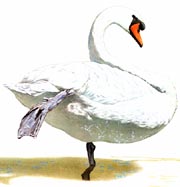
Painting: Walter Ferguson
genus: Cygnus species: olor
Recognition: 56 - 62 inches long. Large, white, and long-necked. Neck held in graceful curve. Bill orange, with black knob. Young tinged with dusky, bill grayish, without knob. Often swims with wings held saillike over back.
Habitat: Ponds and lakes in residential areas.
Nesting: Nest is a large mass of plant material near edge of water. Eggs 4-6, blue-grey. Inclubation 34-38 days, mostly female. Young downey; leave nest soon after hatching; stay with parents four months. Usually nests in isloated pairs; sometimes in loose colonies.
Food: Aquatic plants.
The loud hisses and upraised wings of a male mute swan warn intruders away from its nest.
Originally an inhabitant of Europe and Asia, the mute swan was introduced into the United States in the mid 1800s to grace the ponds of estates and parks. Today, thousands of descendants of those original pairs are living wild, and their numbers continue to multiply.
Mute swans are widely noted as mates for life, but even in the orderly world of swans this is not quite the case, About 5 per cent of their matings appear to break up, although the reasons remain unclear. Can lash out with terrifying speed a neck blow strong enough to break the arm of a full-grown man.
Reference:
-
Book of North American Birds. Cassidy, J.; Scheffel, R. L.; Ferguson, G. Eds. Readers Digest Association Inc. 1990.
![[Previous]](../previous_off.gif)
![[Enlarge]](../enlarge_off.gif)
![[Next]](../next_off.gif)